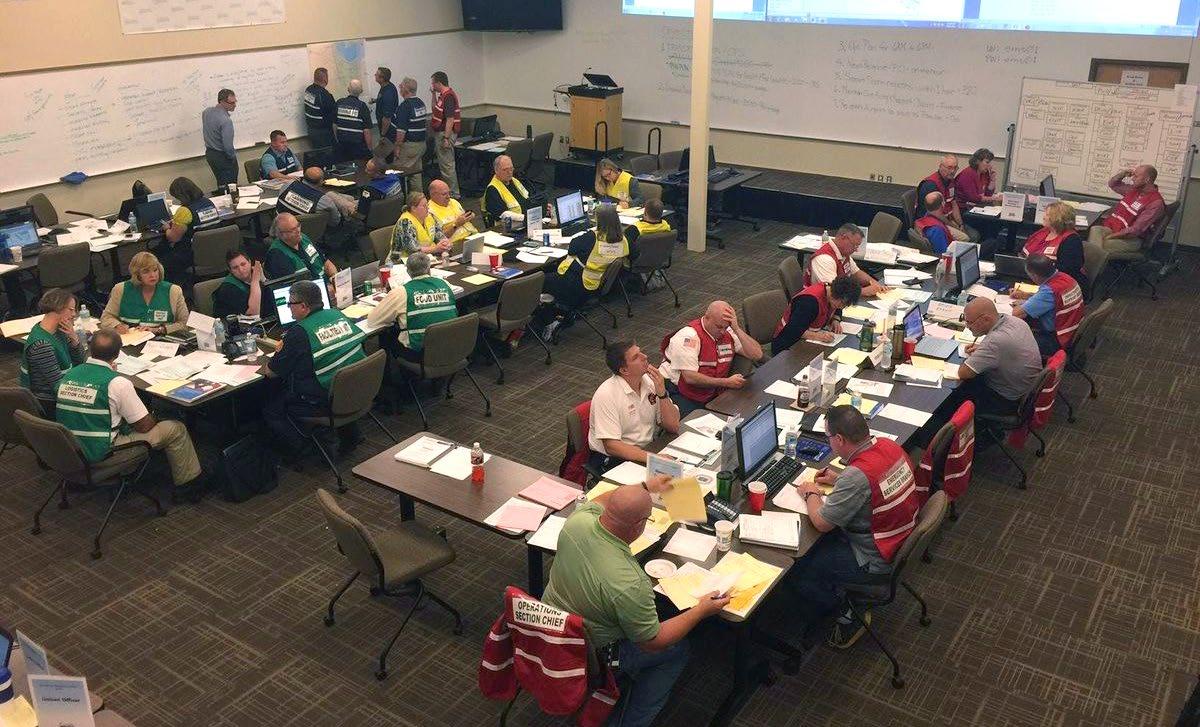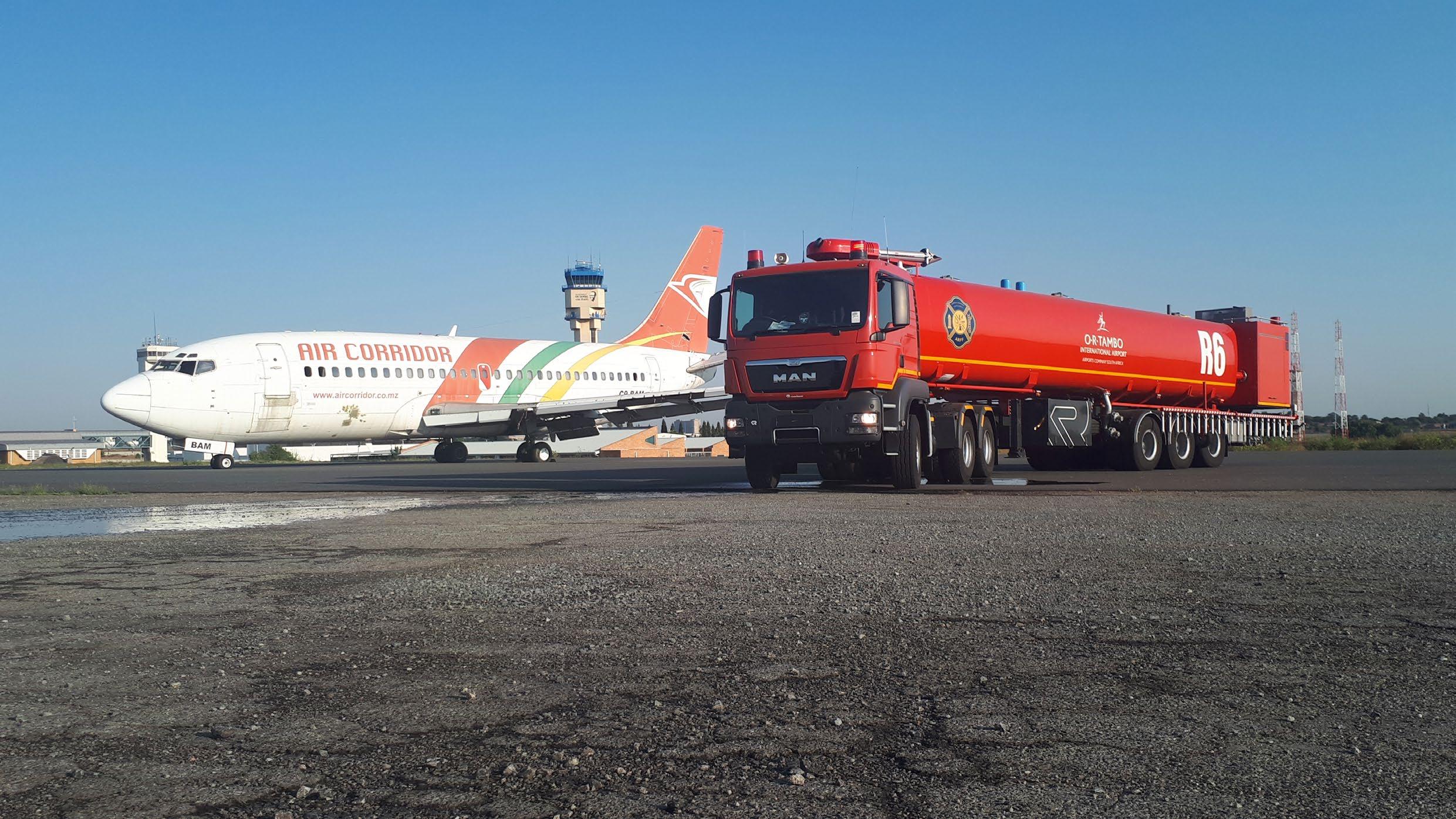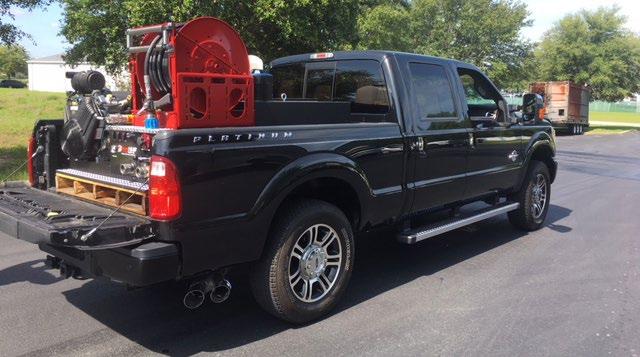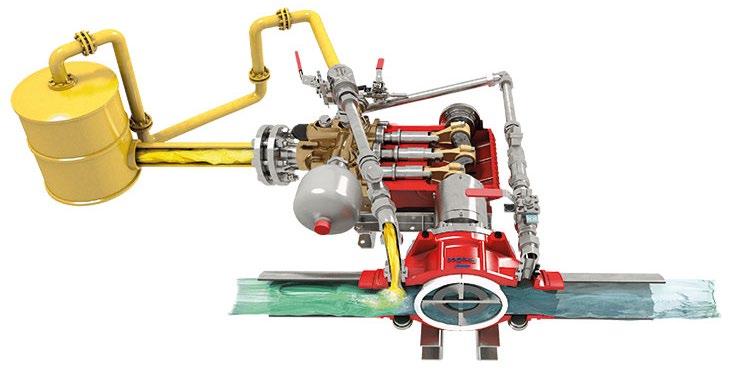
11 minute read
Mobile fire fighting technology for high hazard applications Mobile fire fighting technology for high hazard applications - by Stuart Phythian
Mobile fire fighting technology for high hazard applications
By Stuart Phythian, FireDos
Advertisement
Fighting high hazard and storage tank fires is one of the most challenging scenarios firefighters and crisis management teams must plan for and manage. Fixed fire protection systems are increasingly being supplemented by versatile mobile equipment. Industry changes in foam fire fighting techniques present some special challenges for equipment manufacturers for a response combining both fixed and mobile equipment.
The occurrence of high hazard fires has reduced in the last few years suggesting training and testing standards have generally improved, supported by testing from industry bodies such as JOIFF and LASTFIRE by sharing best practice amongst the enduser community members. This is an achievement in that global storage capacity is expected to double in the 20 years from 2005 to 2025 from approximately 600 million cubic metres (cbm) to over a billion cbm.
However, the industry faces increasing challenges and opportunities. These include the legislative and enforced change from environmentally harmful PFAS type foams to fluorine-free foams (FFF). The increased use of very-large tanks, more than 100 metres diameter becoming more challenging to extinguish. The oil and gas industry adoption of Industry 4.0 and digital solutions for remote monitoring, control and testing, meaning a reduction in site manpower requirements. Some unknown factors and a reduced level of well-trained manpower mean a higher risk. The use of mobile fire fighting equipment which is easy-to-deploy and use will become more important as an integral method to fight large fires as the cost and complexity of fixed systems increases. Fixed systems will always remain a central hub of any fire protection system but fires break out often due to unknown and uncontrollable events and fixed systems may get damaged by the fire incident itself, calling for some level of flexible response.
Fixed systems Fixed systems typically consist of a fire water main pump feeding a hydrant or ring line with fixed monitors, foam pourers for tanks and sprinkler systems for storage areas. The foam concentrate is stored in a fixed atmospheric or pressurised storage tank, with a proportioner to deliver the recommended mix of foam concentrate into the extinguishing water stream.
Modern fire protection systems have introduced a degree of remote and automated operation such as flame and heat detection, as well as remote control, ensuring personnel are kept out of harm’s way as much as possible. The selection of equipment varies, often with a trade-off in terms of operating cost, performance, reliability, testing and size.
Due to the large size, complexity and cost of fixed fire fighting equipment, operators and end-users are increasingly looking to provide hybrid solutions. The ideal being a fire protection system using a fixed system aided by a team with versatile mobile equipment, which can be rapidly deployed, depending on the hazard.
Mobile fire fighting equipment Mobile fire fighting equipment primarily includes the use of high capacity monitors and associated equipment, such as hoses and hose laying equipment and where necessary foam tankers and proportioning equipment.
The challenges for many mobile applications are the potentially long hose lengths, restricted diameters and the pressure drop associated with many pieces of equipment.
Bladder tanks and balanced pressure proportioner systems combined with venturi-based
FireDos GENIII method of operation including test function recirculating foam concentrate to the foam concentrate tank
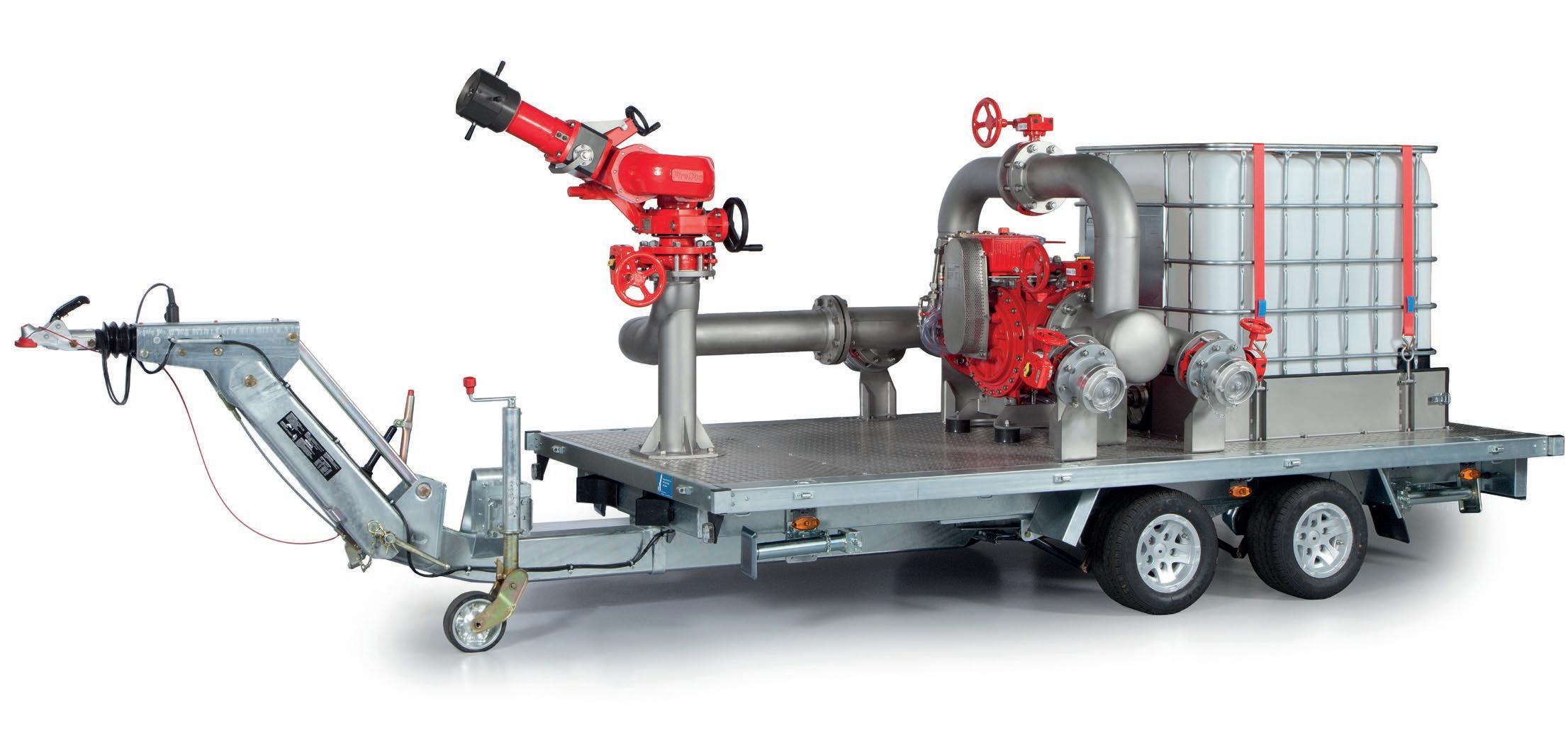
Integrated foam storage tank, foam proportioner and monitor trailer for small applications: FireDos M3 up to 4 000lpm
proportioners (eductors/inductors) or wide range proportioners are designed for fixed installations with a fixed range of pressures and flows. Typically, they are easy to design and install but like all engineered systems, there is a trade-off. One of these is their lack of suitability for mobile applications and varying fire fighting approaches.
Venturi type proportioners, including jet ratio controllers are not suited to modern mobile applications when faced with non-Newtonian high shear-rate and high-viscosity foam concentrates. Foam proportioning rates become more important, especially with FFF foam concentrates, as Venturi’s cannot guarantee a specific proportioning rate at varying water flows.
Foam pumps are also only suited for fixed installations due to their need for external power, such as electronic control units and an electric motor or diesel engine. The ideal design for mobile equipment is components that are external power independent with a low pressure-loss, consistent proportioning rates irrespective of foam concentrate viscosity at varying water flows and back pressures that are easily and rapidly deployed. Mobile proportioner design The two main criteria of any foam proportioner is proximity to the foam concentrate source and its pressure loss. If foam proportioners can deliver the required foam rates without large pressure losses to monitors, mobile systems become more attractive to system designers and fire fighters alike. FireDos GENIII hydraulically driven foam proportioners present significant advantages:
Accurate proportioning rates The water from a hydrant or ring main is used to drive the positive displacement water motor, which in turn drives the plunger pump of the foam proportioner. As each revolution of both the water motor and proportioning pump have a fixed volume, we can easily determine the fixed proportioning rate. As the water flow increases through the water motor, this in turn increases the volume of foam concentrate pumped into the outlet of the water motor and into any mobile foam outlet devices such as monitors and hoses. Unlike other proportioners, the FireDos GENIII is entirely independent of the system pressure and will generate the required proportioning rates independent of any system pressure and flow fluctuations. Testing The cost of operation of any foam extinguishing system must consider the ongoing foam proportioner testing costs, including any clean-up and disposal costs. Having the ability to circulate the foam concentrate back to the foam concentrate tank is a major saving provided by FireDos GENIII proportioners. This eliminates any short- or long-term environmental impact, such as associated disposal and even mobile foam testing can comply with NFPA11 testing requirements.
Capacity limitations It is common to locate the foam concentrate tank, proportioner and monitor together on the trailer. The size of an intermediate bulk container (IBC) tank typically contains 1 000 litres of foam concentrate, providing a limited fire fighting capability. For small applications up to 1 000 to 2 000 litres extinguishing water per minute (lpm) with a three percent nominal foam proportioning rate, an integrated trailer could provide up to 17min at full flow. At a one percent nominal proportioning rate this is triple the time (up to 50min). The use of an integrated trailer solution offers the advantage of rapid deployment, as additional
foam concentrate supply can be organised separately.
For medium water flows above 2 000 to 4 000lpm, separate mobile proportioners fed by foam concentrate tankers are recommended. This aids in the rapid deployment and setup as the position of a monitor is not dictated by the location of the bulk foam concentrate supplies or the accessibility of a foam concentrate tanker.
The versatility of FireDos foam proportioners means they are not susceptible to changes in back pressure or flow restrictions, guaranteeing foam quality at the specified percentage regardless of flow rate.
Foam concentrate viscosity Depending on the type of foam concentrate, the foam concentrate viscosity, proximity to the proportioner and foam concentrate suction piping diameter and design can all have an adverse effect on the performance of any foam proportioning system.
At FireDos, as manufacturers of foam proportioning equipment, we see many applications regardless of proportioner type, where the foam concentrate suction line to the proportioner is designed without adequate consideration of the above-mentioned aspects, resulting in ineffective foam systems.
Unlike low viscosity foam concentrates such as AFFF, many new FFF are non-Newtonian, pseudoplastic and highly viscous. The FireDos GENIII is designed to overcome the challenges in the handling of highviscosity foam concentrates.
Pressure loss The pressure loss of an extinguishing system can be the difference between a system working or not. This means careful consideration must be taken for the firewater-main pressure, the maximum hose lengths and equipment such as the monitors and proportioners. The GENIII is designed with a maximum pressure drop of up to 1,5 to 1,9 bar, dependent on operating conditions. A low-pressure drop across the proportioner, combined with an ideally designed monitor, mobile mounted equipment becomes a more attractive option.
Ideal monitor design Fire fighting monitors for mobile use should be easily transportable, rapidly deployed, easy to operate with a lowpressure drop from inlet to the nozzle. FireDos introduced their range of F- approved fire fighting monitors for water and foam with flows ranging from 500lpm at six bar to 60 000lpm at 16 bar. Each model is designed using the following characteristics for trailer mounting:
Low-pressure drop, balanced design Long lengths of hose and associated equipment such as foam proportioners, ‘rob’ muchneeded pressure to deliver monitors and nozzles the pressure
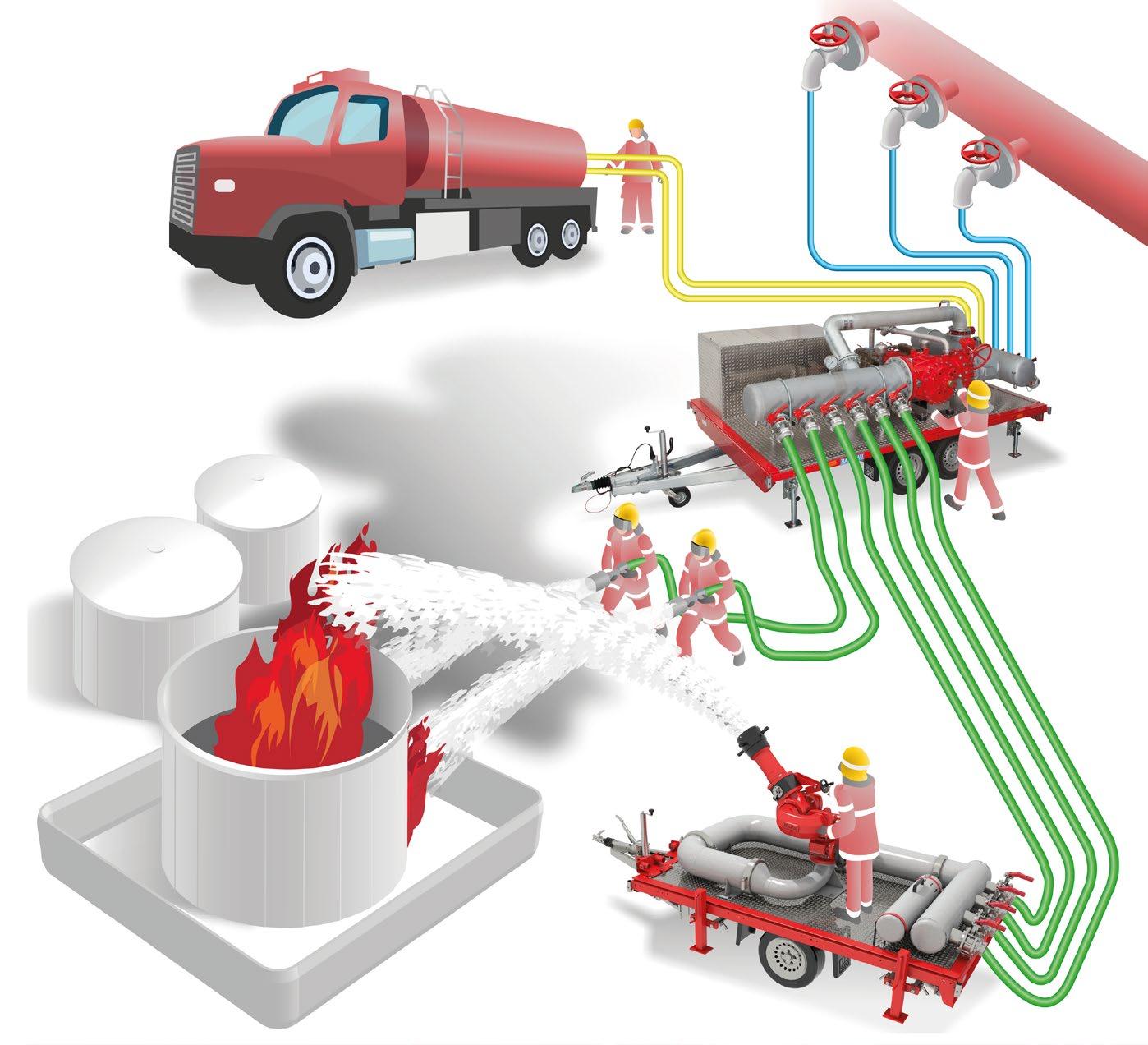
Typical FireDos water driven foam proportioner fed by a foam concentrate tank feeding a trailer mounted monitor and two hand nozzles fighting a tank fire and bund protection

Trailer-mounted monitor design
required to develop a reasonable throw and reach wanted to keep personnel out of harm’s way and to reach the intended target. This is especially important on large storage tanks. FireDos redesigned the internal monitor pipework using a computational fluid dynamics programme to minimise flow restrictions and came up with the “oval-flat” design, which led to a class-leading pressure drop of less than one bar at full flow and therefore a longer throw and reach.
No ballast tank required The design of many other monitors necessitates the requirement for a big ballast tank to stabilise the trailer. A big ballast tank takes time to fill, empty and adds a ‘deadweight’ making trailer movement and re-deployment difficult. The balanced design works to counteract these forces by acting upon itself to balance the pressures out, thereby minimising the reaction forces. The reduced ballast needed is created within the optimised monitor inlet piping. By sizing the piping on the trailer accordingly no additional ballast tank is necessary, aiding in rapid deployment and accessibility to more varied terrain. Adjustable flow during operation When fighting different classes of fire with newer foams (FFF) with varying drainage times, changing flow during operation means more rapid control of a fire hazard situation. Many monitor designs must be switched off and isolated to change the flow, delaying the fire fighting effort. Enabling the flow to be changed by means of a handwheel mid-flow, as with the FireDos AMPN nozzle, without stopping and isolating during continued operation of the monitor also means the fire fighting operation is not interrupted.
If a “banking or raindrop” type of fire fighting attack is required, as is sometimes recommended for type III methods ie when using AR-AFFF, adjusting the flow midstream provides an added advantage. A more accurate flowstream footprint can be obtained by modifying the angle of attack, combined with altering the flow based on weather conditions.
Conclusion The reputational damage associated with large fires is often worse than the tangible costs as the PR costs often outweigh the physical costs. Modern operators now must consider the costs of foam discharges and any short- or longterm damage to the environment.
Utilising equipment designed for mobile use, rather than modifying equipment initially designed for fixed extinguishing systems is one such method to achieve better outcomes.
Mobile fire fighting equipment, ideally designed for rapid deployment and ease of use means less manpower is required to operate and with longer throws and reaches, keeps fire fighters further out of harm’s way.
Ultimately, modern approaches to designing hardware using CFD and FEA techniques making them easier to operate and faster to deploy, with features such as integral testing without discharging foam to the environment or changing flow rates during operation, means the industry is safer and more responsive than ever before.
Local units supplied by DoseTech to date include three custom-built trailer systems: 1. 22 000l/min three percent foam dosing with FireDos proportioner and FireDos monitor with a reach of 120 metre 2. 2. 18 000l/min three percent foam dosing with FireDos proportioner, used for accurate, easy to use foam and water dosing for use on existing portable monitors, rim seal and bund pourers 3. 20 000l/min one percent, three percent and six percent dosing with FireDos proportioner, use for dosing all types of foam concentrate available on the facility, on existing high flow monitors, rim seal and bund pourers, said Mike Feldon, managing director of DoseTech Fire in South Africa.
This article has been reproduced by kind permission of MDM Publishing Ltd. The article first appeared in the October 2020 issue of Gulf Fire magazine (www.gulffire.com) and was submitted by Mike Feldon, managing director of DoseTech Fire in South Africa.




